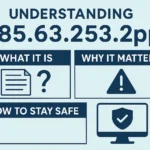In October 2024, TheJavaSea.me, a platform operating on the dark web, became the epicenter of a significant data breach known as the AIO-TLP leak. This incident exposed a vast array of sensitive information, including personal, corporate, and governmental data, underscoring the critical importance of robust cybersecurity measures.
Understanding TheJavaSea.me
TheJavaSea.me is a controversial platform notorious for hosting and distributing leaked data from various sources. Operating primarily on the dark web, it serves as a hub for sensitive, often illegally obtained information, posing serious risks to privacy, national security, and corporate confidentiality. The site’s anonymity and encrypted operations make it challenging for law enforcement to trace its operators or shut it down.
Deciphering AIO-TLP
AIO-TLP, or All-In-One Threat Level Protocol, is a classification system used to evaluate and categorize the severity of leaked data based on its potential impact. It employs a color-coded scheme to distinguish between different levels of information sensitivity:
- White: Publicly accessible information posing no security risk.
- Green: Information restricted to specific groups but not critically sensitive.
- Amber: Sensitive information that, if shared outside a defined group, could have negative consequences.
- Red: Highly sensitive data that could cause significant harm if exposed, often restricted to a few individuals with special clearance.
In the context of TheJavaSea.me, the AIO-TLP system was exploited to categorize and disseminate leaked information, with “Amber” and “Red” classifications indicating the most dangerous types of leaks.
The Breach Unveiled
The AIO-TLP leak involved the unauthorized release of a vast amount of sensitive data, including personal credentials, internal communications, corporate secrets, and governmental information. The breach originated from multiple sources, such as phishing attacks, malware infections, and insider threats. Notably, the attackers exploited several critical vulnerabilities within TheJavaSea.me’s security infrastructure:
- Outdated Software: The use of outdated software components allowed attackers to exploit a zero-day vulnerability, gaining initial access to the platform’s systems.
- Inadequate Input Validation: Insufficient input validation made the platform susceptible to SQL injection attacks, enabling unauthorized access to sensitive data.
- Weak Employee Security Practices: Attackers capitalized on poor security practices among employees, such as falling victim to phishing campaigns, to gain further access to confidential information.
Impact on Users and Organizations
The ramifications of the AIO-TLP leak were extensive, affecting individuals, corporations, and governmental bodies:
- Individuals: Personal data, including names, email addresses, and financial information, was exposed, leading to increased risks of identity theft, financial fraud, and targeted phishing attacks.
- Corporations: Proprietary information, strategic plans, and internal communications were leaked, resulting in reputational damage, financial losses, and potential legal liabilities.
- Governmental Bodies: Sensitive governmental data was compromised, posing threats to national security and diplomatic relations.
Lessons Learned and Preventative Measures
The AIO-TLP breach serves as a critical reminder of the importance of robust cybersecurity practices. Organizations can mitigate the risk of similar incidents by implementing the following measures:
- Regular Software Updates and Patch Management: Ensuring all software components are up-to-date to protect against known vulnerabilities.
- Implementing Strong Input Validation: Employing rigorous input validation to prevent SQL injection and other code injection attacks.
- Employee Training and Awareness Programs: Conducting regular training to educate employees on the latest threats, phishing tactics, and best practices for maintaining security.
- Conducting Regular Security Audits: Performing comprehensive security audits and penetration testing to identify and address vulnerabilities proactively.
- Developing a Robust Incident Response Plan: Establishing a well-defined incident response plan to detect, contain, and mitigate the effects of cyberattacks effectively.
In conclusion, the AIO-TLP breach at TheJavaSea.me underscores the ever-evolving nature of cyber threats and the necessity for organizations to remain vigilant, proactive, and resilient in their cybersecurity efforts.










